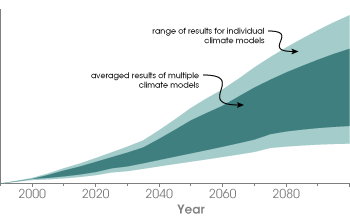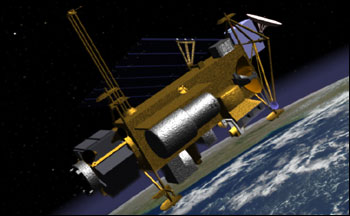

Will Runaway Water Warm the World?by Holli Riebeek • March 15, 2004 Design by Robert Simmon |
|||
It was hot. Hotter than any record in the books. Instead of photographing picturesque fountains in the towns of southern France, tourists were soaking in them. In London, trains sat quietly in the stations; officials were too afraid that the metal tracks would buckle to allow a speeding engine to race over them. Sparked by hot, dry conditions, wildfires raged across France, Spain, Portugal, and Italy. Swiss mountain glaciers thinned more than any other year in the past decade. The doomsday-like heat wave that engulfed Europe in July and August 2003 also carried a darker toll. In France alone, 14,802 more people died that August than in the same month the previous year; for all of Europe, the unofficial death toll reported in the media soared to 19,000. Were these unusually high temperatures—up to ten degrees Celsius hotter than 2001—a result of global warming? It’s not clear, but some fear that the summer’s heat may be an ominous harbinger of some future climate. |
|||
 |
|||
Across the globe, temperatures are slowly creeping up. According to the U.S. National Climatic Data Center, the global average surface temperature has gone up 0.4 degrees Celsius (plus or minus 0.1 degree) in the past 25 years alone. While the extra heat may not have you sweating yet, larger increases are predicted, and that has some people tugging at their collars. The Intergovernmental Panel on Climate Change, a policy advisory group made up of members of the World Meteorological Organization and the United Nations Environment Programme, estimates that the average global surface temperature could climb anywhere from 1.4 to 5.8 degrees Celsius by the year 2100. |
Once a thick tongue of ice that poured into the Gletsch valley (inset), the Rhone Glacier has shrunk dramatically since 1850. In 2003, the Rhone Glacier and other Swiss glaciers retreated more than any other year since scientists began taking measurements in the 1800s. While the summer’s extreme temperatures caused the glaciers to thin more than usual, scientists say that the glaciers retreated in response to long-term warming. (Photograph copyright bigfoto.com, inset courtesy Library of Congress) |
||
 |

Part of the reason the predicted temperature range is so great is that scientists don’t entirely understand whether the atmosphere will become more humid as it warms, and humidity is one of the primary factors that will influence how much the climate will warm over the next century. If the humidity of the atmosphere does indeed increase, it can as much as double the warming from carbon dioxide alone. Thus, an understanding of how the humidity of the atmosphere will change is of fundamental importance in predicting future climate. The problem is one that Ken Minschwaner and Andrew Dessler, researchers at NASA Goddard Space Flight Center, have worked to remedy using data from the Upper Atmosphere Research Satellite (UARS). |
Predictions of warming in the next 100 years vary by about 5 degrees Celsius, from a low of 1.4 degrees to a high of 5.6 degrees. The wide variation is due in part to uncertainty in the magnitude of the feedback between warming and increased rates of evaporation. In this graph, dark green areas represent predictions based on the averaged results of multiple climate models, while light green areas represent the predictions of single climate models. (Graph adapted from Climate Change 2001: The Scientific Basis) |
|

Minschwaner, also a Professor of Physics at the New Mexico Institute of Mining and Technology, and Dessler, also a researcher with the University of Maryland’s Earth System Science Interdisciplinary Center, formulated a simple, one-dimensional model to describe how the humidity of the atmosphere will change as the Earth heats up in response to carbon dioxide emissions from burning of fossil fuels. Surprisingly, their model predicted smaller increases in humidity in the upper atmosphere than large global climate models do, and data collected by the Microwave Limb Sounder and the Halogen Occultation Experiment on NASA’s UARS satellite support their model. Their findings imply that the Earth will warm significantly, but probably not as much as most global climate models predict. Their results appeared in the Journal of Climate on March 15, 2004. |
Using instruments aboard NASA’s Upper Atmosphere Research Satellite (UARS), scientists measured humidity high in the atmosphere. The researchers then compared those humidity measurements with sea surface temperature records. Using these observations, the researchers quantified the feedback between rising temperatures and increasing concentrations of water vapor in the atmosphere. This crucial variable in climate change estimates had previously been based on speculation and modelling, but not direct observations. (Rendering by Jesse Allen, NASA GSFC) |
||